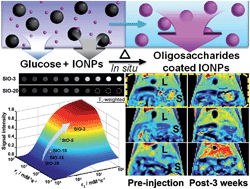Facile non-hydrothermal synthesis of oligosaccharide coated sub-5 nm magnetic iron oxide nanoparticles with dual MRI contrast enhancement effects†
Abstract
Ultrafine sub-5 nm magnetic iron oxide nanoparticles coated with oligosaccharides (SIO) with dual T1–T2 weighted contrast enhancing effects and fast clearance have been developed as magnetic resonance imaging (MRI) contrast agents. Excellent water solubility, biocompatibility and high stability of such sub-5 nm SIO nanoparticles were achieved by using the “in situ polymerization” coating method, which enables glucose to form oligosaccharides directly on the surface of hydrophobic iron oxide nanocrystals. Reported ultrafine SIO nanoparticles exhibit a longitudinal relaxivity (r1) of 4.1 mM−1 s−1 and a r1/r2 ratio of 0.25 at 3 T (clinical field strength), rendering improved T1 or “brighter” contrast enhancement in T1-weighted MRI in addition to typical T2 or “darkening” contrast of conventional iron oxide nanoparticles. Such dual contrast effects can be demonstrated by liver imaging with T2 “darkening” contrast in the liver parenchyma but T1 “bright” contrast in the hepatic vasculature. More importantly, this new class of ultrafine sub-5 nm iron oxide nanoparticles showed much faster body clearance than those with larger sizes, promising better safety for clinical applications.

- This article is part of the themed collection: 2014 Journal of Materials Chemistry B Hot Articles

 Please wait while we load your content...
Please wait while we load your content...